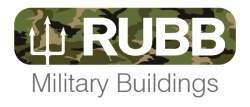
Rubb’s Expeditionary Forces Aircraft Shelter System (EFASS) range features relocatable rapid erect hangars, which are suitable for military land and sea vehicle maintenance and storage requirements.
The company’s vehicle hangars are available in several sizes, with a wide selection of door options to accommodate all types of military vehicles. Hangars include storage and maintenance areas to support operations.
Rubb Hangar Advantages
The EFASS range covers all operations with three different span widths of 11.1m (36ft), 20.4m (67ft) and 25m (82ft) to suit a range of client requirements.
Hangars are capable of withstanding wind loads of VE 41.6m/s and snow loads of 100kg per m2, while the high grade 6082 T6 aluminium leg and roof sections ensure structural reliability while remaining light enough to be transported.
Rubb uses the highest quality and strongest PVC coated fabric for its hangars, enhancing durability and ensuring an effective working environment. Hangars feature easily-repairable fire-retardant double skin insulated PVC fabric cladding with a U-value of 1.68 W/m²K.
The typical building lengths of Rubb vehicle hangars range from 12m to 100m and are extendable by a further 4m bay to suit customers operations.
Rubb’s complete EFASS range of military hangars pack into certified front and side opening 20ft ISO containers and the company provides special packing inspection sheets (SPIS) to ensure items are packed and unpacked in conjunction with military specifications.
EFASS are supplied with their own integral foundation arrangements, including various adaptations and accessories to securely anchor the structure to the ground. The structure can also easily be adapted from an aircraft hangar to a warehouse.
Rubb’s lightweight vehicle hangars feature individual packing configurations to be delivered by land, sea or air. Hangars are fully relocatable and can fit into containers for transport and storage.
EFASS military hangars have an excellent reliability track record and have been proven to last in excess of 30 years. They are currently used by many military organisations around the world, including the UK Royal Air Force.

